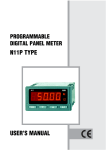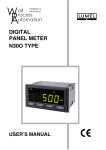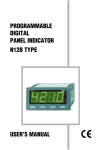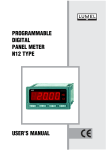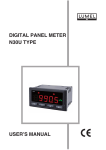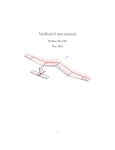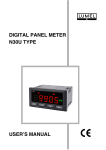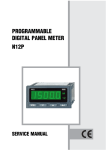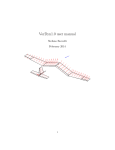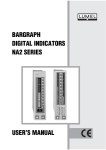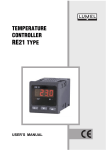Download N11O TYPE USER`S MANUAL
Transcript
PROGRAMMABLE DIGITAL PANEL METER N11O TYPE USER’S MANUAL PROGRAMMABLE DIGITAL PANEL METER N11O TYPE CONTENTS Page 1.APPLICATION....................................................................... 5 2.BASIC REQUIREMENTS, OPERATIONAL SAFETY............ 6 3.FITTING................................................................................. 7 4.CONNECTION....................................................................... 8 5.SERVICING........................................................................... 9 6.PROGRAMMING................................................................. 15 7.TECHNICAL DATA............................................................... 24 8.BEFORE A FAILURE WILL BE DECLARED....................... 28 9.PROGRAMMING EXAMPLES OF N11 METERS............... 29 10.EXECUTION CODES.......................................................... 33 11. MAINTENANCE AND WaRrantY..................................... 34 October 2006 - KZ 1299/06 1. APPLICATION N11O programmable digital panel meters are destined for measurement of the number of pulses, number of rotations, number of working hours, frequency, period and rotational speed. These meters additionally enable the indication of the current time. A 5 or 4-digit display field (14 or 20mm heigh digits), in red or green colour ensures a good readability at a long distance. They realized other additional functions as: signalling of the set alarm value exceeding, possibility to rescaling the input signal, counting of pulses up and down, automatic resetting of counters at the set value, possibility of external resetting, stoppage and start of counters, signalling of the measuring range exceeding, programmable measurement repetition rate, storage of maximal and minimal values, storage of counter contents after a supply decay (impulse counter, revolutions and worktime counters), monitoring of set parameters values, blocking of the parameter introduction by means of a password, recalculation of the measured quantity into any quantity on the base of an individual linear characteristic, lead out to sensor 24 V d.c. highlighting of any optional measuring unit as per the order. With the meter we deliver: - a warranty card, - 4 holders to fix the meter into a panel, - a service manual, - a plug with screw connections or self-locking connections, - a set of stickers with units. When unpacking the meter, please check whether the type and execution code on the data plate correspond to the order. Symbols located in this service manual mean: - especially important, one must acquaint with this before connecting the meter. - one must take note of this when the meter is working inconsistently to the expectations. 2. BASIC REQUIREMENTS, OPERATIONAL SAFETY N11O meters are destined to be mounted into panels and cubicles. In the range of operational safety they are in conformity with the EN 61010-1 standard requirements. Remarks concerning the operator safety: The installation and meter connection should be operated by a qualified personnel. One must take into consideration all accessible protection requirements. Before switching the instrument on, one must check the correctness of the network lead connection acc. to EN 610101-1 standard In case of the protection terminal connection with a separate lead one must remember to connect it before the connection of network leads. Do not connect the meter to the network through an autotransformer. Before taking the meter housing out one must turn the supply off. The removal of the meter housing during the warranty period may cause its cancellation, A circuit breaker should be installed in the building installation. It must be easily accessible for the operator. 3. FITTING Prepare a (92+0.6 x 45+0.6) mm hole in the panel. The thickness of the material from which the panel is made can not exceed 15 mm. One should introduce the meter from the front of the panel with disconnected supply circuit. After introducing the meter, fasten it by means of holders. Fig. 1. Overall dimensions 4. CONNECTION At the rear side of the meter there is a terminal strip seat. A connector with screw terminals or a self-locking connector is added to the meter depending on the meter type chosed in the ordering code. The fig. 2. shows the connection way of external signals. The description of the connector is also printed on the meter housing. In case of a meter working in an environment of high perturbances one should use external filters. It is recommended to use screened leads on the meter input. As a feeder cable one must use a two-wire cable and choose the lead cross-section such that in case of a short-circuit from the device side, the protection of the cable was ensured by means of the electric installation fuse. Requirements related to the feeder cable are regulated by the IEC 1010-1 p.6.10. and p.6.11.2. standard. It is recommended to use shielded wires on the meter input and output. Connection ways of input signals to the N11O meter. a) Description of terminal strip of the N11O meter b) Connection of extrminal Start and Stop buttons c) Connection of the PCID proximity sensor Fig. 2. Sposób podłączenia sygnałów wejściowych do miernika N11O 5. SERVICING After switching the meter on, its type and next the program version are displayed. After ca 10 sec., the meter transits automatically into the measuring mode and the input signal value is displayed. The meter blanks automatically insignificant zeros. The exceeding of the alarm threshold is signalled by means of alarm diodes 1 and 2. The basic unit of the measured value is automatically highlighted by the meter 1). a) b) Fig. 3. Description of the meter faceplate a) 5-digit execution b) 4-digit execution 1) No exists in the 4-digit (20mm) execution. 10 Key functions: - acceptance key entry into the programming mode (hold down during ca 3 seconds), moving through the menu - choice of the level, entry into the change mode of the parameter value, acceptance of the changed parameter value. - key to increase the value displaying of the maximal value, start of the counter (if E_In = „OFF”) entry to the parameter group level, moving through the chosen level, change of the chosen parameter value - increase of the value succeeding parameter in the monitoring mode - key to decrease the value displaying of the minimal value, stoppage of the counter (if E_In = „OFF”) entry to the parameter group level, moving through the chosen level, change of the chosen parameter value - decrease of the value succeeding parameter in the monitoring mode - erasing key entry to the menu of parameter monitoring (hold down during ca 3 seconds), exit from the monitoring menu, erasing of the parameter change, absolute exit from the programming mode 11 The pressure of the and key combination causes the erasing of alarm signalling. This operation exclusively acts when the support function is switched on. The pressure of the and key combination causes: the erasing of the minimal value when measuring the period, frequency or rotational speed, the resetting and stoppage of counters in case of pulse number, rotation number measurements or a working time counter. The pressure of the and key combination causes: the erasing of the maximal value when measuring the period, frequency or rotational speed, the resetting and start of counters in case of pulse number, rotation number measurements or a working time counter. The pressure of the key during the measurement causes: in case of frequency, period or rotational speed, the display of the maximal value, in other cases, the counter start when E_In = „OFF”. The release of the key causes the return to the display of the currently measured value. The pressure of the key during the measurement causes: in case of frequency, period or rotational speed, the display of the minimal value, in other cases, the counter stoppage when E_In = „OFF”. The release of the key causes the return to the display of the currently measured value. The pressure and the holding of the key down during ca 3 sec. causes the entry into the programming matrix. The programming matrix is secured by the safeguard code. 12 The pressure and the holding of the key down during ca 3 sec. causes the entry into the monitoring menu. After the monitoring menu, one must move by means of and keys. In this menu, all programmable meter parameters, except service parameters, are only accessible to the read-out. The exit from the monitoring menu takes place by means of the key. On the monitoring menu, parameter symbols are alternately displayed together with their values. The fig. 4. shows the operation algorythm of the meter. In case of switching on the external functions E_In = „0n”, the start, stop and resetting of the counters are carried out from external leads 3, 4, 5 (see fig. 2). Giving a 5...24 V d.c. signal on the lead -out „start”, „stop” we will cause the stoppage of the counter. The break of the signal will cause the start of the counter. Giving a 5...24 V d.c. voltage on the lead-out „Reset”, we will cause the reset of the counter. The appearance of the following symbols on the digital displays means: - Incorrect introducing of the security code. - Exceeding of the upper measuring range. - Exceeding of the lower measuring range or lack of signal. 13 14 Fig. 4. Operation algorythm of the N110 meter 6. PROGRAMMING The key pressure and its holding down during ca 3 seconds causes the display of the security code symbol SEC alternately with the 0 value set up by the manufacturer. The entrance of the correct code causes the entry into the programming matrix. The transition matrix into the programming mode is shown on the fig. 5. We choose the level by means of the key, whereas the entry and moving through parameters of the chosen level is carried out by means of the and keys. Parameter symbols are displayed alternately with their actual values. In order to change the value, one must use the key. To key. resign of the parameter change one must press the To exit from the chosen level one must select the - - - symbol and press the key. In order to exit from the programming matrix into measurement, one . must press the The inscription HEY occurs and after ca 5 sec. the meter will automatically enter into the measurement of the input quantity. Way of changing the value of the chosen parameter In order to increase the value of the chosen parameter one must press the key. A single pressure of this key causes a value increase of 1. The hold of the pressed key causes a continuous increase of the value up to display the 0 value. The jump to the next digit follows after this value. The further change is similar. The key release in any moment causes a jump to the first digit. It is similarly in case of the value decrease. The single pressure of the of one. The hold of the key causes a value decrease key pressure causes a continuous 15 decrease of the value till the display of 0. The jump to the next digit follows after this value. The further change is similar. The key release in any moment causes a jump on the first digit. In order to accept the set up parameter one must press the key. Then, the writing of the parameter and display of its symbol follow alternately with the new value. The pressure of the key during the change of the parameter causes the resignation of the record. (1) - exists only, when the individual characteristic is included (Ind = On) (2) - exists only in executions with 5 displayed digits Fig. 5. Transition matrix into the programming mode 16 TABLE 1 Parameter symbol Description Range of changes tYP Selection of the measured value SCAL Choice of input quantity rescaling And - multiplication by kind. constant The measured quantity is multiplied diu - division by constant or divided by the set value (ConS parameter). In case of the choice of the input type as a pulse counter, rotations or time counter and multiplication function, each impulse causes the increase of the displayed quantity by the ConS value. In case of the choice of the input type as a pulse counter, rotations or time counter and division function, only a pulse number equal to the ConS constant will cause the change of the displayed value by 1. In other cases the function is not serviced. In 4-digit execution: Rescaling constant of the -1999...9999 input value. The writing of a negative value in case of In 5-digit execution: -19999...99999 counting pulses, rotation number and work time causes a count down. Permission for external func- On - external function switched on tions: start, stop, reset. OFF - external function switched off ConS E_In Cntr - pulse number FrEC - frequency turn - rotation number tACH - rotational speed PEr - period PErH - long period > 10 sec CntH - work time counter Hour - current time 17 table 1 (continuation) Auto Automatic counter reset. The counter is automatically reset at the set number. This parameter is not take into consideration when measuring the frequency, rotational speed and period. Cnt Averaging time for the Ind H1, Y1 H2, Y2 d_P 18 In 4-digit execution: 0...9999 In 5-digit execution: 0...99999 In 4-digit execution: 0.0...999.9 s In 5-digit execution: 0.0...9999.9 s The 0 writing causes the measurement switching off and the display blanking. Switching off or on the individual On - switched on characlinear characteristic of the user. teristic OFF - switched off characteristic measurement of frequency period and rotational speed. Restoration time of indications for counters. Parameters of the individual characteristic. On the base of given coordinates of two points by the user, the meter assigns coefficients of the individual characteristic a and b Y = aH + b. H1 and H2 - measured value Y1 and Y2 - expected value on the display In 4-digit execution: -1999...9999 In 5-digit execution: -19999...99999 Setup of the decimal point. This setup works only at switched on individual characteristic. Setting possibilities: in 4-digit execution: 0000 000.0 00.00 0.000 in 5-digit execution: 00000 0000.0 000.00 00.000 0.0000 PrL1 PrL2 Alarm lower threshold In 4-digit execution: -1999...9999 In 5-digit execution: -19999...99999 In 4-digit execution: -1999...9999 In 5-digit execution: -19999...99999 PrH1 PrH2 Alarm upper threshold tYP1 tYP2 Alarm type. The fig. 6. shows the graphical illustration of alarm types nor - normal On - switched on OFF - switched off H_On - manually switched on, till the time of changing the alarm type, the alarm output is switched on for good. H_OF - manually switched off, till the time of changing the alarm type, the alarm output is switched off for good. dLY1 dLY2 Delay of alarm operation. The parameter is defined by the number of measurements, one must give after how many measurements the alarm operation follows. The alarm switching off follows without delay. The parameter takes in account the number of averaged measurements Cnt and treats the whole cycle of averaging as a single measurement. In 4-digit execution: 0...9999 In 5-digit execution: 0...99999 The introduction of 0 causes the operation at the moment of alarm appearance. LEd1 LEd2 Support of the alarm signalling. In the situation when the function of support is switched on after the withdrawal of the alarm state, the signalling diode is not blanked. On - support switched on OFF - support switched off 19 table 1 (continuation) The function signals the alarm state till the moment of its blanking by means of the combination of and keys. This function only and exclusively concerns the alarm signalling and the relay contacts will act without support, according the chosen alarm type. tyPO The choice of the quantity which will be converted into pulses and sent to the pulse output. In case of a work time counter, pulses are sent every each Con0 seconds to the pulse output. In case of a pulse counter, pulses with a 2Con0 frequency are sent to the pulse output. OFF - switched off Cntr - pulse number CntH - work time counter SEt Restoration of manufacturer′s settings. Parameter values set up by the manufacturer are shown in the table 2. SEC Introduction of a new password A pressure of the key causes the writing down of standard parameters into the meter. The execution of this operation is signalled by the inscription End. In 4-digit execution: -1999...9999 In 5-digit execution: -19999...99999 tSt Display test. The test consists on consecutive switching on of digital display segments. Alarm diodes and highlighted diodes of the unit should be lightened. 20 The pressure of the key causes the test switching on. The ends the test. Hour Setup of the current time JEd (Unit) 0.00...23.59 The introduction of a wrong time will cause its writing in the memory, but after the exit from the matrix, the meter will correct the error. I.e. the introduction e.g. the time 0.70 will cause that the meter will treat this as minutes and set 1.10. Highlight switching on of the unit. On - highlighting switched on OFF - highlighting switched off ____ Exit of the parameter group from the chosen level. The pressure of the key causes the exit of the parameter group from the chosen level. 21 a) nor PrH > PrL b) nor PrH PrL c) OFF d) On Fig. 6. Alarm type a), b) normal c) switched off d) switched on 22 CAUTION ! In case of On and OFF alarm types, the writing down of PrL>PrH will cause an automatic transcription of the value from the threshold PrL into PrH and from threshold PrH into PrL. The alarm type will not change. In case of a measuring range exceeding the relay reaction is concordant with written down PrL, PrH and tYP parameters. In spite of displaying the exceeding, the meter will carry out the measurement as before. In case of an individual characteristic switching on (Ind=On) the measurement result is transformed linearly in accordance with introduced H1, Y1, H2, Y2 parameters. The linear characteristic does not operate in case of choice of the current time as the input type. The meter currently checks up the value of the actually introduced parameter. In case when the introduced value exceeds the upper range of changes given in the table 1, the meter will automatically carry out the change into the minimal value. Similarly, in case when the introduced value exceeds the lower range of changes given in the table 1, the meter will automatically carry out the change into the maximal value. The display format of the current time in the 5-digit meter: g.mmss, after exceeding 9.5959:ggg.mm, after exceeding 999.59:ggggg. The display format in the 4-digit meter: gg.mm, after exceeding 99.59 gggg. where: g=number of hours, m=number of minutes, s=number of seconds. The position of the decimal point, in the programming mode, in dependence on the input signal: - number of pulses, rotations, number of work hours, long period, rotational speed - lack of point. - frequency - 0.00 and period - 0.0. 23 Standard parameters of the meter TABLE 2 Parameter symbol Level in the matrix Standard value tYP SCAL ConS E_In Auto Cnt Ind H1,Y1,H2,Y2 d_P PrL1, PrL2 PrH1, PrH2 tYP1, tYP2 dLY1, dLY2 LEd1, LEd2 tYPO ConO SEC Hour JEd 1 1 1 1 1 1 1 1 1 2, 3 2, 3 2, 3 2, 3 2, 3 4 4 5 5 5 Cntr diu 1 OFF 9999 lub 99999 1.0 OFF 0 0000. lub 00000. 0 9999 or 99999 OFF 0 OFF OFF 1 0 0.00 On 7. TECHNICAL DATA Panel meter dimensions 96 x 48 x 84 mm Protection index ensured from the meter frontal side IP50 Protection index ensured from the terminal side IP20 24 Rated operating conditions - supply voltage depended on the execution code - supply voltage frequency - ambient temperature - air relative humidity Power consumption 85... 253 V a.c. d.c. 20... 40 V a.c. d.c. and 20... 50 V d.c. 40...50...440 Hz -20...23...50°C < 95% (water vapour conden- sation inadmissible) max 7 VA Storage temperature -20...+85°C Display field - N11O4 - N11O5 four 7-segment LED displays 2 alarm diodes five 7-segment LED displays two alarm diodes two diodes to the unit highlighting Indication range of the digital display: - N11O4 -1999...9999 - N11O5 -19999...99999 Servicing four keys Relay outputs - programmable alarm thresholds, - three types of alarms (see chapter 6), - hysterezis defined by means of the lower and upper alarm threshold, - signalling of alarm action by means of diodes, - programmable delay of the alarm operation. - two relay outputs 25 - voltageless make contacts - maximal load capacity: - voltage - 250 V a.c., 150 V d.c. - current - 5 A 30 V d.c., 250 V a.c. - resistance load - 1250 VA, 150 W Pulse output - voltageless, OC type, with a npn transistor (max. load 25 mA) - range of added voltages: 5...24 V d.c. - galvanic insulation Control inputs (start, stop, erasing) - voltageless (transoptor input) - range of added voltages: 5...24 V d.c. - galvanic insulation Sensor supply 24 V d.c./max 30 mA (galvanic insulation) Electromagnetic compatibility: - immunity acc. EN 61000-6-2 - emission acc. EN 61000-6-4 Safety requirements: according IEC 1010-1 standard: - installation category III - level of pollution 2 - maximal voltage in relation to the earth: - supply: 300 V - inputs: 50 V - relay outputs: 50 V - supply of 2-wire object transducers: 50 V Meter parameter - long-lasting exceeding of the upper range 10% - entry galvanically insulated 5...24 V a.c., d.c. - maximal frequency of the counter operation 20 kHz - maximal frequency of remaining parameters: 1.1 kHz - storage of counter contents after the supply decay (impulse counter, revolution and worktime counters) 26 Table 3 Kind of input Indication range 5 digits Number of pulses Basic error 4 digits 0...99999 0...9999 0,01% i.v. 1) 0,01% i.v. Number of rotations 0...99999 0...9999 Number of working 0...99999 h 0...9999 h 1sec/24 hours Frequency 0.05...9.999 Hz 0.05...9.999 Hz 0.02% i.v. Frequency 10.00...99.99 Hz 10.00...99.99 Hz 0.02% i.v. Frequency 100.0...1000.0 Hz 100.0...999.9 Hz 0.2 % i.v. Rotational speed 0...10000 t/min 0...9999 t/min 0,02% i.v. Rotational speed 10000...99999 t/min lack 0.2% u.l.s. Period 0...999.99 ms 0...999.9 ms 0,01% i.v. Period 1.0000...9.9999 s 1.000...9.999 s 0.02% i.v. Period 10...99999 s 10...9999 s Current time 0.00...23.59 0.00...23.59 1 sec/24 hours 1 second where: i.v. = indicated value u.l.s. = upper limit of the measuring subrange Time of preliminary heating 5 minutes Weight 0.2 kg Time of measurement programmable, min. 100 ms 27 8. BEFORE A FAILURE WILL BE DECLARED SYMPTOMS PROCEDURE 1. The meter does not operate Check the connection of the feeder cable 2. Only the diodes are lighting Number of measurements = 0 has been introduced. The meter operates in the SLEEP mode - the display is blanked. 3. Only the horizontal dashes are displayed Check the correctness of the input signal connection. See page 7 and 11 in the service manual. 4. Only the inscription noC is displayed The meter is discalibrated, Contact the nearest authorized service workshop. 5. The entry into the programming mode is not possible.The inscription Err is displayed. The programming mode is protected by the password. If the user forgets which password has been introduced one must contact the nearest authorized service workshop. 6. Lack of certainty if all display segments are efficient Enter into the service mode and switch on the display test. In the same time the same segments should be lighted on all displays. The state with blanked displays does never occur. Otherwise, submit the defect to the nearest authorized service workshop. 7. During the operation in the programming mode, parameter values inconsistent with the range of changes given in the table 1, occur on the display Enter into the service mode and accept the SEt parameter. The meter will introduce values in accordance with the table 2. 8. A result inconsistent with our expectations occurs on the display. Check if the individual characteristic is not switched on. In case of necessity enter into the service mode and accept the SEt parameter. The meter will introduce parameters in accordance with the table 2. 9. H1, Y1, H2, Y2, d_P parameter symbols are not displayed in the programming mode. In case of switched individual characteristic off, mentioned symbols are omitted. 28 10. Despite of the alarm threshold exceeding, neither the alarm relay nor the signalling diode is switched on. Check the introduced delay in the alarm operations into the meter. If need be, correct the dLY parameter. 11. Despite of the relay switching off, the alarm diode does not switch off. Check if the alarm signalling support is not switched on. In case of need, switch off the LED parameter. 12. Lack of possibility to erase the signal- The alarm still lasts. The erased diode is ling diode by means of the key combi- immediately re-lighted. nation (fig. 4.) when the parameter of alarm signalling support is switched on. 13. Despite the fact that the alarm still remains, the signalling diod does not light up. Check if a delay of the alarm operation has not been introduced. dLY parameter 14. Instead to display the measurement result, the meter displays the parameter symbol alternately with its value despite we were not entered into the programming mode. The meter works in the reviewing mode. 15. A delay of the alarm operation has been introduced, e.g. 30 measurements, however after this time the alarm has not operated. The lasting alarm state was shorter than the programmed, e.g. during the lasting time of the alarm the state of alarm withdrawal occurs. In that case the meter begins counting the measurements from the beginning. 9. PrOGRAMMING EXAMPLES OF N11O METERS Example 1: Programming of an individual characteristic. If we want to programme so that the value 0.0 ms will correspond to the value 0 on the display, whereas the value 10000 will correspond to the value 500,0 ms one must: choose the Ind parameter and switch the individual characteristic on, 29 choose the H1 parameter and introduce the value 0.0 pass on the Y1 parameter and introduce the value 0, pass on the H2 parameter and introduce the value 500.0, pass on the Y2 parameter and introduce the value 10000. pass on the d_P parameter and set the decimal point on the position 00000 After the exit from the programming mode, the meter automatically begins to recount the input signal on the base of the programmed characteristic. Example 2 - Programming of an inverse individual characteristic. If we want to programme so that the value 50.00 Hz will correspond to the value 1200.5 on the display, whereas the value 999.99 Hz will correspond to the value 10.8, one must: choose the Ind parameter and switch the individual characteristic on, choose the H1 parameter and introduce the value 50.00 pass on the Y1 parameter and introduce the value 12005, pass on the H2 parameter and introduce the value 999.99, pass on the Y2 parameter and introduce the value 108, pass on the d_P parameter and set the decimal point on the position 0000.0 After the exit from the programming mode, the meter automatically begins to recount the input signal on the base of the programmed characteristic. Example 3 - Programming of the alarm with hysteresis If we want to programme the alarm 1 operation so that the alarm will be switched on at the value 850.0 ms, whereas switched off at the value 100 ms, and the alarm 2 so that at the value 1000.0 ms the alarm will be switched off and on at the value 1.0 ms, one must: enter into the programming mode and choose the level with the 30 exit from the ALr1 level and pass on the ALr2 level, choose the PrL2 parameter and introduce the value 1000.0, pass on the PrH2 parameter and introduce the value 1.0, pass on the tYP2 parameter and choose the function nor., After the exit from the programming mode, the meter begins to control newly introduced alarm thresholds after executing each measurement. Example 4 - Programming of an alarm operating in the given interval with delay. If we want that the alarm 1 will be switched on in the interval from 1000 up to 3000 and operated only after 10 sec., one must: enter into the programming mode and choose the Alr1 level, pass on the PrL1 parameter and introduce the value 1000, pass on the PrH1 parameter and introduce the value 3000, pass on the tYP1 parameter and choose the On function, pass on the dLY1 parameter and set 10, introduce under the Cnt parameter the value 1.0, exit from the programming mode. Example 5 - Programming the meter so that it counts the rotations. The meter co-operates with a sensor with a constant: 60 pulses / turn. enter into the programming mode and choose the tYP parameter, choose the input type as turn, pass on the SCAL parameter and set diu, pass on the ConS parameter and set the value 60, exit from the programming mode. The meter starts to count the rotations. 31 Example 6 - Programming the pulse counter so that it counts down and so that after exceeding 0 it starts to count from the value 12546 again. enter into the programming mode and choose the tYP parameter, choose the input type as Cntr, pass on the ConS parameter and set the value -1, pass on the Auto parameter and set the value 12546, exit from the programming mode. The meter starts to count the number of pulses from 12546...0 and after exceeding 0, it starts to count from 12546...0 again. 32 10. EXECUTION CODES N11 METER X X X X X XX X Input: temperature, programmable input 1 V, 10 V, 20 mA, 200 mA (all d.c. ranges) 600 V, 1 A, 5 A (all d.c. ranges) turns, frequency, period, pulses single-phase parameters as per the order T S H O P X Number of displays: 4 x 20 mm high digits 5 x14 mm high digits Display colour: red green Supply voltage 230 V a.c. d.c. 24 V a.c. d.c. Kind of terminals: socket - plug with screw connections socket - plug with self-locking connections Execution: standard custom-made 4 5 0 1 1 2 0 1 00 XX Acceptance tests: without a quality acceptance test with a quality inspection certificate acc. customer′s agreement 0 1 X Unit field: introduce the unit symbol XXX 33 Order example: N11-O-5-0-1-0-00-1 Hz means: a frequence meter standard signals, with 5 displays in red colour, voltage supply: 230 V a.c., d.c., kind of terminals: socket-plug with screw connections, standard execution, with a quality inspection certificate , with the highlighted Hz unit. • In case of a custom-made execution or need of more detailed technical information please contact our Export Department. • In case of any meter failure one must contact the nearest authorized service workshop. 11. MAINTENANCE AND GUARANTEE The N11O meter does not require any periodical maintenance. In case of some incorrect unit operations: 1. From the shipping date, during the period given in the annexed guarantee card One should take the meter down from the installation and return it to the Manufacturer’s Quality Control Dept. If the unit has been used in compliance with the instructions, the Manufacturer guarantees to repair it free of charge. 2. After the guarantee period: One should turn over the meter to repair in a certified service workshop. The disassembling of the housing causes the cancellation of the granted guarantee. Spare parts are available for the period of five years from the date of purchase. The Manufacturer policy is one of continuous improvement and we reserve the right to make changes in design and specification of any products as engineering advances or necessity requires and revise the above specification without notice. 34 35 SALES PROGRAMME MEASUREMENT DIGITAL PANEL METERS CONTROL BARGRAPH INDICATORS RECORDING MEASURING TRANSDUCERS ANALOGUE PANEL METERS (DIN INSTRUMENTS) DIGITAL CLAMP-ON METERS PROCESS and HOUSEHOLD CONTROLLERS CHART and SCREEN RECORDERS POWER CONTROL UNITS and FREQUENCY INVERTERS AUTOMOTIVE DASHBOARD INDICATORS STATIONARY and PORTABLE CALIBRATORS MEASUREMENT ACCESSORIES (SHUNTS, SENSORS, TRANSFORMERS) MEASURING SYSTEMS (ENERGY, HEAT, CONTROL, MEASUREMENT) CUSTOM-MADE PRODUCTS WE ALSO OFFER OUR SERVICES IN THE PRODUCTION OF: ALUMINIUM ALLOY PRESSURE CASTINGS PRESSURE CASTING DIES AND INJECTION MOULDS PRECISION ENGINEERING AND THERMOPLASTICS PARTS QUALITY PROCEDURES: According ISO 9001 international requirements. All our instruments have CE mark. For more information, please write to or phone our Export Department. Lubuskie Zak³ady Aparatów Elektrycznych LUMEL S.A. ul. Sulechowska 1, 65-022 Zielona Góra, Poland Tel.: (48-68) 3295 100 (exchange) Fax: (48-68) 3295 101 e-mail:[email protected] http://www.lumel.com.pl Export Department: Tel.: (48-68) 3295 302 or 304 Fax: (48-68) 3254 091 e-mail: [email protected]




































